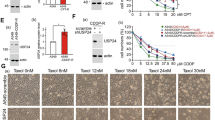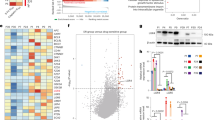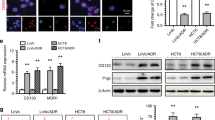Abstract
The multidrug resistance (MDR) mediated by P-glycoprotein (P-gp), the MDR1 gene product, is one of the major obstacles in leukemia treatment. The present study was designed to explore a MDR1-targeted small interfering RNA (si-MDR1) approach for reversal of P-gp-mediated MDR in the MDR human leukemia cell line k562/A02. It was found that si-MDR1 significantly inhibited MDR1 expression at both mRNA and protein levels. Depletion of MDR1 by si-MDR1 correlated with the increased sensitivity of the cells to cytotoxic agents and with the enhanced intracellular retention of daunorubicin (DNR). One base-pair mutated control (si-MDR1-Mut) lost the effect of si-MDR1 on both the degradation of mdr1 mRNA and the reduction of P-gp expression. These findings indicate that siRNA specifically and efficiently interferes with the expression of mdr1 and could be used as a molecularly defined therapeutic approach for MDR in the treatment of leukemia.
This is a preview of subscription content, access via your institution
Access options
Subscribe to this journal
Receive 12 print issues and online access
$259.00 per year
only $21.58 per issue
Buy this article
- Purchase on Springer Link
- Instant access to full article PDF
Prices may be subject to local taxes which are calculated during checkout



Similar content being viewed by others
References
Kartner N, Riordan JR, Ling V . Cell surface P-glycoprotein associated with multidrug resistance in mammalian cell lines. Science. 1983;221:1285–1288.
Gros P, Ben Neriah YB, Croop JM, Housman DE . Isolation and expression of a cDNA (mdr) that confers multidrug resistance. Nature. 1986;323:728–731.
Fardel O, Lecureur V, Guillouzo A . The P-glycoprotein multidrug transporter. Gen Pharmacol. 1996;27:1283–1291.
Campos L, Guyotat D, Archimbaud E, et al. Clinical significance of multidrug resistance P-glycoprotein expression on acute nonlymphoblastic leukemia cells at diagnosis. Blood. 1992;79:473–476.
Pirker R, Wallner J, Geissler K, et al. MDR1 gene expression and treatment outcome in acute myeloid leukemia. J Natl Cancer Inst. 1991;83:708–712.
Wianny F, Zernicka GM . Specific interference with gene function by double-stranded RNA in early mouse development. Nat Cell Biol. 2000;2:70–75.
Williams BR . Role of the double-stranded RNA-activated protein kinase (PKR) in cell regulation. Biochem Soc Trans. 1997;25:509–513.
Elbashir SM, Harborth J, Lendeckel W, Yalcin A, Weber K, Tuschl T . Duplexes of 21-nucleotide RNAs mediate RNA interference in cultured mammalian cells. Nature. 2001;411:494–498.
Wu H, Hait WN, Yang JM . Small interfering RNA-induced suppression of MDR1 (P-glycoprotein) restores sensitivity to multidrug-resistant cancer cells. Cancer Res. 2003;63:1515–1519.
Tan Y, Li G, Zhao C, et al. Expression of sorcin predicts poor outcome in acute myeloid leukemia. Leuk Res. 2003;27:125–131.
Yang CZ, Luan FJ, Xiong DS, Liu BR, Xu YF, Gu KS . Multidrug resistance in leukemic cell line K562/A02 induced by doxorubicin. Acta Pharmacol Sinica. 1995;16:333–337.
Wilda M, Fuchs U, Wossmann W, Borkhardt A . Killing of leukemic cells with a BCR/ABL fusion gene by RNA interference (RNAi). Oncogene. 2002;21:5716–5724.
Sugawara I, Watanabe M, Matsunaga A, Itoyama S, Ueda K . Primer-dependent amplification of mdr1 mRNA by polymerase chain reaction. Jpn J Cancer Res. 1992;83:131–133.
Hamada H, Tsuruo T . Functional role for the 170- to 180-kDa glycoprotein specific to drug-resistant tumor cells as revealed by monoclonal antibodies. Proc Natl Acad Sci USA. 1986;83:7785–7789.
Zaman GJ, Flens MJ, van Leusden MR, et al. The human multidrug resistance-associated protein MRP is a plasma membrane drug-efflux pump. Proc Natl Acad Sci USA. 1994;91:8822–8826.
Den Boer ML, Pieters R, Kazemier KM, Janka-Schaub GE, Henze G, Veerman AJ . Relationship between the intracellular daunorubicin concentration, expression of major vault protein/lung resistance protein and resistance to anthracyclines in childhood acute lymphoblastic leukemia. Leukemia. 1999;13:2023–2030.
Motomura S, Motoji T, Takanashi M, et al. Inhibition of P-glycoprotein and recovery of drug sensitivity of human acute leukemic blast cells by multidrug resistance gene (mdr1) antisense oligonucleotides. Blood. 1998;91:3163–3171.
Lambert E, Rees JK, Twentyman PR . Resistance circumvention strategies tested in clinical leukaemia specimens using the MTT colorimetric assay. Leukemia. 1992;6:1063–1071.
Cioca DP, Aoki Y, Kiyosawa K . RNA interference is a functional pathway with therapeutic potential in human myeloid leukemia cell lines. Cancer Gene Ther. 2003;10:125–133.
Wohlbold L, Van Der Kuip H, Miething C, et al. Inhibition of bcr-abl gene expression by small interfering RNA sensitizes for imatinib mesylate (STI571). Blood. 2003;102:2236–2239.
Heidenreich O, Krauter J, Riehle H, et al. AML1/MTG8 oncogene suppression by small interfering RNAs supports myeloid differentiation of t(8;21)-positive leukemic cells. Blood. 2003;101:3157–3163.
Nagasawa K, Takara K, Nomiyama M, Ohnishi N, Yokoyama T . Transport mechanisms of anthracycline derivatives in human leukemia cell lines: uptake of pirarubicin, daunorubicin and doxorubicin by K562 and multidrug-resistant K562/ADM cells. Biol Pharm Bull. 1996;19:971–976.
Schlemmer SR, Sirotnak FM . Functional studies of P-glycoprotein in inside-out plasma membrane vesicles derived from murine erythroleukemia cells overexpressing MDR 3. Properties and kinetics of the interaction of vinblastine with P-glycoprotein and evidence for its active mediated transport. J Biol Chem. 1994;269:31059–31066.
Hamada H, Tsuruo T . Functional role for the 170- to 180-kDa glycoprotein specific to drug-resistant tumor cells as revealed by monoclonal antibodies. Proc Natl Acad Sci USA. 1986;83:7785–7789.
FitzGerald DJ, Willingham MC, Cardarelli CO, et al. A monoclonal antibody-Pseudomonas toxin conjugate that specifically kills multidrug-resistant cells. Proc Natl Acad Sci USA. 1987;84:4288–4292.
Marthinet E, Divita G, Bernaud J, Rigal D, Baggetto LG . Modulation of the typical multidrug resistance phenotype by targeting the MED-1 region of human MDR1 promoter. Gene Therapy. 2000;7:1224–1233.
Claudina A, Jean-Philippe A, Xing JL, et al. P-glycoprotein, expressed in multidrug resistant cells, is not responsible for alterations in membrane fluidity or membrane potential. Cancer Res. 2003;63:3084–3091.
Tuschl T . Expanding small RNA interference. Nat Biotechnol. 2002;20:446–448.
Paddison PJ, Caudy AA, Hannon GJ . Stable suppression of gene expression by RNAi in mammalian cells. Proc Natl Acad Sci USA. 2002;99:1443–1448.
Brummelkamp TR, Bernards R, Agami R . A system for stable expression of short interfering RNAs in mammalian cells. Science. 2002;296:550–553.
Brummelkamp TR, Bernards R, Agami R . Stable suppression of tumorigenicity by virus-mediated RNA interference. Cancer Cell. 2002;2:243–247.
Abbas-Terki T, Blanco-Bose W, Deglon N, Pralong W, Aebischer P . Lentiviral-mediated RNA interference. Hum Gene Ther. 2002;13:2197–2201.
Stewart SA, Dykxhoorn DM, Palliser D, et al. Lentivirus-delivered stable gene silencing by RNAi in primary cells. RNA. 2003;9:493–501.
Narasaki F, Matsuo I, Ikuno N, Fukuda M, Soda H, Oka M . Multidrug resistance associated protein (MRP) gene expression in human lung cancer. Anticancer Res. 1996;16:2079–2084.
List AF, Spier CS, Grogan TM, et al. Overexpression of the major vault transporter lung resistance protein predicts treatment outcome in acute myeloid leukemia. Blood. 1996;87:2464–2469.
Illmer T, Schuler US, Thiede C, et al. MDR1 gene polymorphisms affect therapy outcome in acute myeloid leukemia patients. Cancer Res. 2002;62:4955–4962.
McCaffrey AP, Meuse L, Pham TT, Conklin DS, Hannon GJ, Kay MA . RNA interference in adult mice. Nature. 2002;418:38–39.
Sorensen DR, Leirdal M, Sioud M . Gene silencing by systemic delivery of synthetic siRNAs in adult mice. J Mol Biol. 2003;327:761–766.
Acknowledgements
We thank Professor Chunzheng Yang for providing the cell line K562/A02 and Ms Ming Feng for technical assistance. This work is supported by grants of 863 (2001AA215311, 2002AA223354) and 973 (001CB5101) from the Ministry of Science & Technology of China to Han ZC.
Author information
Authors and Affiliations
Corresponding author
Rights and permissions
About this article
Cite this article
Peng, Z., Xiao, Z., Wang, Y. et al. Reversal of P-glycoprotein-mediated multidrug resistance with small interference RNA (siRNA) in leukemia cells. Cancer Gene Ther 11, 707–712 (2004). https://doi.org/10.1038/sj.cgt.7700738
Received:
Published:
Issue Date:
DOI: https://doi.org/10.1038/sj.cgt.7700738
Keywords
This article is cited by
-
Microfluidic cell sorting by stiffness to examine heterogenic responses of cancer cells to chemotherapy
Cell Death & Disease (2018)
-
RNAi-mediated knockdown of target genes: a promising strategy for pancreatic cancer research
Cancer Gene Therapy (2007)
-
Prospects of RNA interference therapy for cancer
Gene Therapy (2006)
-
RNA interference and potential therapeutic applications of short interfering RNAs
Cancer Gene Therapy (2005)



